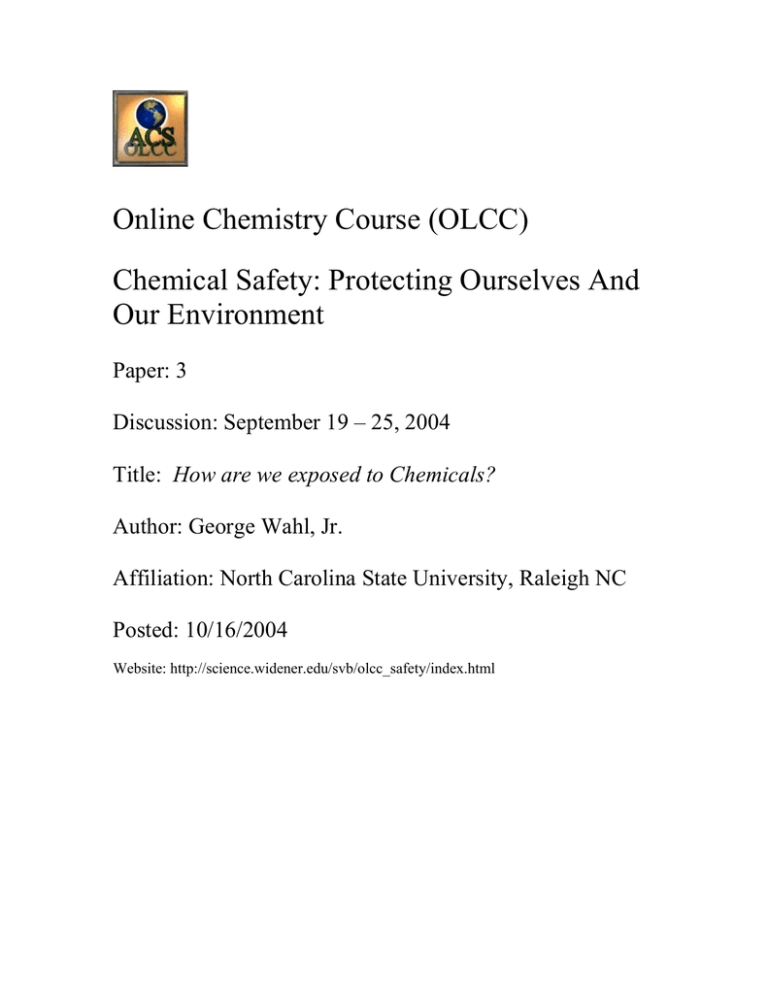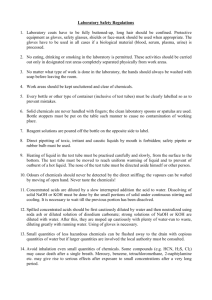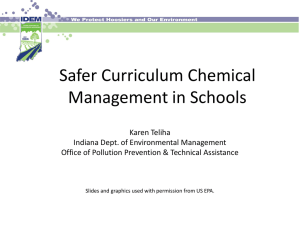Online Chemistry Course (OLCC) Chemical Safety: Protecting Ourselves And Our Environment
advertisement

Online Chemistry Course (OLCC) Chemical Safety: Protecting Ourselves And Our Environment Paper: 3 Discussion: September 19 – 25, 2004 Title: How are we exposed to Chemicals? Author: George Wahl, Jr. Affiliation: North Carolina State University, Raleigh NC Posted: 10/16/2004 Website: http://science.widener.edu/svb/olcc_safety/index.html http://science.widener.edu/svb/olcc_safety/ How are we exposed to Chemicals? - George H. Wahl, Jr. Professor of Chemistry o North Carolina State University Raleigh, NC 27695-8204 Suggested Readings Prudent Practices, CH 3, pp. 35 - 57 SAFETY in Academic Chemistry Laboratories, 7th Ed. Vol. 1 Students, pp. 10-11 As you begin a career of working in the chemical laboratory, it is essential that you become completely familiar with the hazards that you might encounter there, and the proper ways of minimizing the risk that you assume by working there. As you advance in the profession, and become responsible for planning experiments, another level of responsibility emerges, and the following question arises - "What is the best and safest way to do these experiments?" [At your current beginning level, you will usually be given very specific directions, developed by an experienced chemist, and told to follow them.] The introduction to this course included the following statement "The new culture of laboratory safety articulated in the National Academy of Science book "Prudent Practices" is built around experimental planning. Safety is as much a part the design and execution of an experiment as the selection of reagents and glassware. "Prudent Practices" notes that "the culture of laboratory safety depends ultimately on the working habits of individual chemists and their sense of teamwork for protection of themselves, their neighbors, and the wider community and environment." This paper follows on from that idea. We hope to introduce you to ways in which you might become exposed to chemicals in the laboratory. Then we'll present a few things you need to do to minimize the risk of personal injury and damage to the physical surroundings of the lab and the environment. We also hope that as you read through this material you'll see that most of what we say is just pure "common sense" applied to seemingly complicated scientific situations. Perhaps you'll also adopt the question "What would the 'prudent person' do in this situation?" as a way of determining how to minimize risk in just about any situation. It might also be useful to remember the "Five-P Approach" - Prior Planning Prevents Poor Performance. As you reflect on the 5Ps, hopefully it becomes clear that this is (or should be) perfectly obvious. Isn't it true in every day life, that when we carefully think ahead about a task we're called to do, we usually do much better than if we just walked in and started it without any planning? Well in the chemistry laboratory, it is definitely true. We do need to think ahead. We need to run thru a "What if…” series of questions. Such as, what if the condenser water stops running?; or, what if the power goes off?; or, what if the reaction spontaneously overheats? 1 http://science.widener.edu/svb/olcc_safety/ The larger the number of "What if….” scenarios you consider ahead of time, the more well prepared you will be, and the smaller the chance of a dangerous situation developing. Let's look at a couple of real-life incidents as we begin this conversation. Whenever we work in a chemistry laboratory, we need to first consider our attire. What we wear to the mall or on a date is not necessarily appropriate for laboratory work. In the lab, there is always a chance of a spill, or an explosion, or any number of other happenings that could endanger us. For example, Elizabeth Griffin, a 22 year old lab technician at the Yerkes National Primate Research Center in Atlanta was splashed in the eye by bodily fluids from a rhesus macaque monkey as she transferred it from one cage to another. The amount of fluid was so small that she did not consider the episode to be an accident worthy of reporting until she developed symptoms more than a week later. She died of the rare herpes B virus about six weeks after the incident! Could this unfortunate accident have been avoided? Well, very likely. Although Ms. Griffin was following all of the safety regulations current at the time of the accident, they were not adequate! The safety rules did not require eye protection! The infection apparently was through the Ms. Griffin's eyes. If she had been wearing chemical splash goggles at the time, there would not have been the chance for the monkey’s fluids to enter her eye! Since this accident occurred in the workplace, the Occupational Safety and Health Administration (OSHA) investigated. In their initial complaint, OSHA asked for more than $ 100,000 in fines. OSHA specified a number of infractions including a "willful safety and health violation". OSHA claimed that Yerkes didn't provide Griffin with "appropriate eye and face protection against monkey body fluid splashes or monkey scratches." Following Centers for Disease Control and Prevention (CDC) guidelines, Griffin was wearing a lab coat, mask, and gloves while transporting the animal. Eye protection was considered unnecessary for what was considered to be a low-risk activity. Griffin was not directly handling the animal, and at the time herpes B virus was not known to cross intact mucous membranes. This was the first documented case. Take home message? The next time you gripe about excessive eye protection, think of Elizabeth. As you are involved in planning an experiment, be careful to examine the procedure for any chances of spills, or splatters, or other miscues that might bring the experimental chemicals into close proximity to your face. Or, better yet, adopt a rule like - "Anytime anyone in the laboratory is using any chemical, everyone will wear appropriate eye wear." The eye, or life you save may be your own! Another actual, real-life example might be of interest. It also involves a woman, and it too is a case that would not have happened if proper personal protective equipment was worn. 2 http://science.widener.edu/svb/olcc_safety/ Dartmouth Chemistry Professor Karen Wetterhahn, 48, died June 8, 1997 from mercury poisoning. She was exposed to no more than one or two drops of dimethyl mercury on the only day she ever used the highly toxic material. [The American Conference of Governmental and Industrial Hygienists (ACGIH) adopted Threshold Limit Value (TLV) time weighted average (TWA) value for organic mercury compounds is 0.01 mg/m3]. During August 1996, Professor Wetterhahn was preparing a reference standard for some mercury nmr studies she planned to do. She was wearing latex gloves, eye protection, and was working in the hood. She was aware that the substance she was to work with, dimethyl mercury, was highly toxic and she believed she was taking appropriate precautions. Sometime during the few minutes she used the compound, she noticed that she spilled a drop or two on her gloved hand. She immediately washed her gloved hands and thought little more about it. During the Fall 1996 semester, all seemed normal in Karen’s life. Perhaps she was unaware of the latency period involved in mercury poisoning. Sometime in late 1996, she began to experience a loss of balance and began bumping into doors. Her speech became difficult and her hands were tingling. Finally on January 20, 1997 she was hospitalized, and her case began to be understood. Blood tests revealed that her mercury levels were 80 times the lethal limit. Through chelation therapy, doctors were able to reduce her blood levels, but they could not reverse her central nervous system damage. She died in June 1997, 298 days after her single exposure to much less than one milliliter of dimethyl mercury. Of course, OSHA took a strong interest in the case. Dartmouth was cited for failure to adequately train workers about personal protective equipment, particularly the choice of appropriate gloves. Careful testing of the same type of latex gloves as Dr. Wetterhahn was wearing was initiated by Dartmouth. It was determined that dimethyl mercury permeated them in about 15 seconds! In further tests to determine what gloves would be appropriate, only Silver Shield (a proprietary laminate) and a combination of Silver Shield and neoprene were deemed to provide adequate protection against dimethyl mercury. They resisted permeation for more than 240 minutes. Take home message? Wearing personal protective equipment (PPE) is not enough. We must carefully verify that the PPE we choose is appropriate for the materials to be handled. If we ever must use a particularly hazardous material, we should take the time to do extra thorough research on what is known about toxicity, and personal protective equipment. Yet another accident involving an explosion in a laboratory waste chemical disposal incident that occurred at the University of Kentucky is nicely illustrated on-line at - http://www.ilpi.com/safety/explosion.html Please take a look at this web site as soon as possible! In the spring 1997 semester of CHE 533 (Qualitative Organic Analysis Laboratory) at the University of Kentucky, incompatible wastes 3 http://science.widener.edu/svb/olcc_safety/ (http://www.ilpi.com/msds/ref/incompatible.html) were accidentally mixed resulting in a fire and explosion. It is believed that nitric acid and halogenated organic solvents (http://www.ilpi.com/msds/ref/organic.html were involved, but the exact cause may never be known. It is miraculous that there were no serious injuries from this explosion and fire. The student who last used the waste bottle reported that he saw some brown fumes coming from the waste bottle when he added his methylene chloride. He capped the bottle and walked away. A minute or two later it exploded. The explosion blew glass shrapnel across the laboratory. Students on the other side of the laboratory were hit with glass fragments, including at least one who reported that the glass bounced off his safety goggles. Thankfully, this student was following the rule you must wear your safety glasses at all times in the laboratory even if you aren't "doing anything." A fire immediately followed. The hood was completely engulfed in flames and the laboratory (approximately 2000 square feet) quickly filled with smoke so black, thick and acrid that one could not see across the lab. Fortunately, everyone was evacuated and there were no injuries. The fire was contained by faculty members who took a serious (and some would say extremely foolish) risk in battling this large and dangerous fire themselves [Note: see "Fire Extinguishers In The Chemical Laboratory" http://www.ilpi.com/safety/extinguishers.html) for tips about laboratory fires]. Serious injuries were avoided only because the student who normally works opposite that hood was not present at the moment of the explosion. Explosions of this nature can have an induction period ranging from one second to one hour or more. The last student to use this waste bottle was incredibly lucky. Take home message? It should be clear that Waste Chemical containers should be very well labeled. Great care should be encouraged to avoid inadvertent mixing of non-compatible chemicals. In student labs, it is usually best to have specific, welllabeled waste containers for each experiment. Each of these containers should be removed the student laboratory as soon as each experiment ends. This removal should be done only by someone with adequate chemical training and experience. As with all such collection sites, secondary containment should be in place to confine any spillage. The action taken by the faculty member with the fire extinguisher is also something to consider. Often, if we are not trained specifically on the proper use of a piece of safety equipment, we run the risk of serious harm if we attempt to use it under stressful conditions such as described above. Does your institution have a policy on the use of fire extinguishers? Does everyone receive regular fire extinguisher training from an experienced expert? Has everyone had the opportunity to use a fire extinguisher under controlled conditions? Who checks on the contents of each fire extinguisher? How often is this done? Is each fire extinguisher clearly marked to show when it was most recently tested? 4 http://science.widener.edu/svb/olcc_safety/ Hopefully, while you consider the material in this segment of the course, you will try to answer the questions above, as well as those posed below in the description of this segment. TOPIC I. How does a prudent person plan a laboratory experiment? (Sep 19-Oct 9) * What is the availability of MSDS and other safety sources in your laboratory/school? How could this access be improved? * Select a chemical and compare data from the label, MSDS, CLIPS, LCSS, NIOSH and other sources. What information is most significant to a researcher? * What kind of eye protection is required and under what conditions? Are your school's requirements consistent with the recommendations found in the readings? * How are chemicals stored at your school? Is there room for improvement? * What policy should be implemented for pregnant women in the laboratory? * What policy should be implemented for students allergic to certain chemicals? What substances are some of the likely suspects? * Prepare a glossary of safety terms from the list provided. * What is the chain of command at your institution? Revise Figure 1.1 of Prudent Practices to fit the organizational structure of your institution. * Are there any disagreements in the information found in Prudent Practices, SACL and the safety rules adopted at your institution? Evaluate any differences. * What does the cliché, "The dose makes the poison" mean? Give an example. * How can I calculate a toxic dose of a substance? • Compare multiple sources of safety information (one should be an MSDS) and critique them. Possible class projects might include – Your professor may decide to assign each student two chemicals, and to suggest sources of safety information like Merck, Bretherick's, RTEC, etc. You will be asked to summarize the type of information provided, how user friendly each source was (is this reference more for lab employees, or is it useful to "non-lab" personnel who may also come into contact with the chemicals), etc.) Make a map of the commonly used undergraduate lab spaces and label the locations of such items as: electrical shut-offs, water shut-offs, fire extinguishers, exits, safety showers, eyewashes, etc. Visit your region's EPA office and find the articles published with regard to citations against local universities. The students might be asked to rank the citations they find according to dollar amount, and determine what situation caused the most penalties. 5







